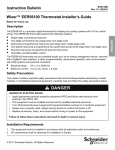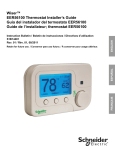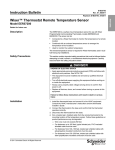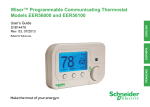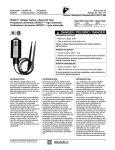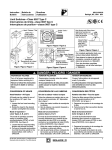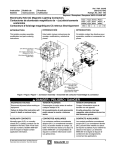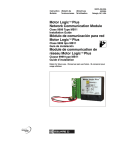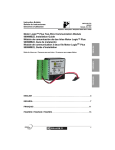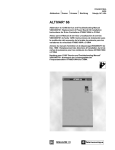Download Wiser EER56000 User`s guide
Transcript
S1B14480 Rev. 01, 08/2011 Instruction Bulletin Wiser™ EER56000 Thermostat Installer’s Guide Retain for future use. Description • • • Single-stage conventional heat/cool Heat pump (two-stage heat / single-stage cool) Dual fuel heat pump (two-stage heat / single-stage cool) The EER56000 thermostat can be controlled locally and, as an energy management device, remotely with a ZigBee® radio interface. It offers programmability, stand-alone operation, and communication with utility systems and personal computers. • • Electrical rating: 24 V; 2 A; 50/60 Hz Maximum current: 2 A on any circuit, 3 A total Safety Precautions This section contains important safety precautions that must be followed before attempting to install, maintain, or troubleshoot electrical equipment. Carefully read and follow the safety precautions below. DANGER HAZARD OF ELECTRIC SHOCK • Apply appropriate personal protective equipment (PPE) and follow safe electrical work practices. See NFPA 70E. • This equipment must be installed and serviced by qualified electrical personnel. • Turn off all electrical power supplying this equipment before working on or inside the equipment. • Always use a properly rated voltage sensing device to confirm that power is off. • Replace all devices, doors, and covers before turning on power to this equipment. Failure to follow these instructions will result in death or serious injury. Installation Requirements 1. This equipment must be installed in accordance with all applicable codes and ordinances. 2. CE requirements must be observed for installation in Europe. © 2011 Schneider Electric All Rights Reserved ™ ENGLISH The EER56000 is a precision digital thermostat designed for heating and cooling systems with 24 Vac control wiring. The EER56000 thermostat supports the following systems: Before installing this thermostat: 1. 2. 3. 4. 5. Read this Installer’s Guide and the User’s Guide, document number S1B14479. Ensure that this thermostat is suitable for the application. Ensure that the wiring complies with all applicable codes and ordinances. Turn off control transformer power. Use a properly rated voltage sensing device to confirm that power is off. Location When replacing an existing thermostat, install the EER56000 thermostat in the same location. If the location does not meet the following criteria, choose a new location: ENGLISH 1. 2. 3. 4. Ensure that the thermostat is mounted 5 ft. above the floor and is at least 2 ft. from an exterior wall. Ensure that the thermostat is located in an area with adequate air circulation. Do not mount the thermostat in the path of direct sunlight or radiant heat generated by appliances. Do not mount the thermostat on an exterior wall, near a fireplace, or in the path of any air ducts. Removing an existing thermostat 1. 2. 3. 4. Turn off control transformer power. Use a properly rated voltage sensing device to confirm that power is off. Remove the cover of the thermostat. Disconnect the wires going to each terminal on the thermostat. Label each wire with the letter or number at the terminal. 5. Remove the plate or base from the wall. Mounting Install the optional EER5700 trim ring if the thermostat you are replacing is larger than the new one. Follow the instructions supplied with the trim ring for mounting the trim ring and thermostat. If you are not installing a trim ring, follow these instructions. Figure 1: Mounting the Thermostat 1. Hold the thermostat by the sides, avoiding the keys, and unsnap the base from the face. 2. Holding the base to the wall so that the word “UP” is upright and facing you, mark the two mounting holes on the wall using a pencil. 3. Using a 3/16 in. diameter drill bit, drill a hole at the mounting hole markings. 4. Install the two wall anchors supplied. 5. Slide the system wires through the opening in the base. 6. Mount the base to the wall using the two #6 x 1/2 in. self-tapping screws supplied. See Figure 1. 2-EN © 2011 Schneider Electric All Rights Reserved Wiring CAUTION HAZARD OF IMPROPER OR UNINTENDED OPERATION Turn off the control transformer power before installing the thermostat. Using a properly rated voltage sensing device, confirm that the power is off. Do not short a gas valve, fan heat relay or cool relay even momentarily. Do not attempt to connect to live circuits. An accidental connection to a component on the thermostat circuit board could damage the thermostat. Failure to follow these instructions can result in equipment damage. 1. Connect the system wires to the terminal strips on the thermostat base per the wiring diagram for the system application. See Figures 3–6. Form the thermostat wiring so that the cable lies flat between the terminal strip and the center of the base. See Figure 2, A. 2. Push all excess wiring into the hole in the wall. Plug the hole with the supplied insulating foam to ensure accurate temperature reading. 3. Visually inspect the temperature sensor. Be sure that it is standing up and that it has not been damaged during installation. See Figure 2, B. 4. Align the tabs of the thermostat face with the slots of the thermostat base. Gently push the thermostat face into the thermostat base locking it into place. See Figure 2, B. Figure 2: Assembling the Thermostat A © 2011 Schneider Electric All Rights Reserved SLOT TAB BASE TEMPERATURE SENSOR WALL B 3-EN ENGLISH • • • • TYPICAL WIRING DIAGRAMS Figure 3: Test and Configuration Power-up UP ENGLISH JUMPER 3 2 1 24 Vac Common 24 Vac "HOT" For HVAC systems with a single transformer for heating and cooling, leave the metal jumper between Terminal 1 (RC) and Terminal 2 (RH) in place. (C) (RC) THERMOSTAT 24 VAC CONTROL TRANSFORMER Notes: 1. For HVAC systems with a single transformer for heating and cooling, leave the metal jumper between Terminal 1 (RC) and Terminal 2 (RH) on the left terminal strip must in place. See Figure 3. 2. The EER56000 thermostat is factory-configured to control a single stage conventional HVAC system. If the HVAC system is a heat pump or a dual fuel heat pump, before operating the thermostat configure the “System Type” settings under “System Options.” See “Setup and Configuration” on page 13. 3. When configured as a conventional thermostat, by default this thermostat does not turn the fan on with a call for heat. If the furnace requires the thermostat to turn the fan on with a call for heat, configure the “System Mode” to “Fan On With Heat” under “System Options.” 4. A conventional thermostat can be configured for automatic changeover heat/cool, manual changeover heat/cool, heat only, or cool only thermostat. Refer to the “Configuration” steps associated with the wiring diagram for the HVAC system type. 5. If the thermostat or HVAC system does not perform as stated in the “Power Up” steps under the wiring diagram for the HVAC system type, recheck all wiring. See Troubleshooting on page 19. 6. For HVAC systems with separate heating and cooling transformers, remove the metal jumper between Terminal 1 (RC) and Terminal 2 (RH) on the left terminal strip. See Figure 4 on page 5. 4-EN © 2011 Schneider Electric All Rights Reserved Figure 4: Connections for Heat and Cool Transfers—Applies to All Systems REMOVE JUMPER For HVAC systems with separate heating and cooling transformers, remove the metal jumper between Terminal 1 (RC) and Terminal 2 (RH) on the left terminal strip. 3 2 1 24 Vac Common 24 VAC HEAT TRANSFORMER (C) 24 Vac Heat "HOT" (RH) 24 Vac Cool "HOT" (RC) 24 VAC COOL TRANSFORMER THERMOSTAT Single-Stage Conventional Figure 5: Connections for Single-Stage Heat/Cool Thermostat UP * Common wire is required in “heat only” or “cool only” applications. Also use a common if the heat, cool, or fan relay cannot supply 15 mA to the power thermostat without activating. 8 7 6 HVAC SYSTEM Fan Relay Fan (G) Cool (Y1) Cool Relay Heat (W1) Heat Relay 3 24 Vac Common* 1 24 Vac "HOT" (C) (RC) THERMOSTAT 24 VAC CONTROL TRANSFORMER Configuration The EER56000 is factory configured as a single-stage conventional heat/cool thermostat. In the factory configuration, the thermostat does not turn the fan on with a call for heat. If the furnace does not turn the fan on with a call for heat, the thermostat must be configured to do so under “System Options.” © 2011 Schneider Electric All Rights Reserved 5-EN ENGLISH UP Power Up ENGLISH 1. Double check the wiring. Be sure there are no stray wires or wire strands at the connections. 2. Turn on power to the transformer and system. The display will show the current thermostat settings. 3. Press [TEMP], then press [MORE]. 4. Scroll to Fan and press [OK]. 5. Set the fan to On. Press [OK] and then press [Back]. The fan should turn on. 6. Navigate back to the Fan screen and set the fan to Auto. Press [OK] and then press [Back]. The fan should turn off. 7. Press [MORE], scroll to Mode, and press [OK]. Set the mode to Heat. Press [OK] and then press [Back]. 8. Raise the desired heat setting above the current temperature. Ensure that the heating unit turns on. 9. Navigate back to the Mode screen and set the mode to Off. Press [OK] and then press [Back]. The heating unit should turn off. 10. Navigate back to the Mode screen and set the mode to Cool. Press [OK] and then press [Back]. Lower the desired cool setting below the current temperature. Ensure that the cooling unit turns on. 11. Navigate back to the Mode screen and set the mode to Off. Press [OK] and then press [Back]. Ensure that the cooling unit turns off. 12. Navigate back to the Mode screen and set the mode to Auto. Press [OK] and then press [Back]. The EER56000 thermostat works with most single-stage conventional 4-wire HVAC systems (without a transformer common). However, if the thermostat resets when calling for heat or cool, or if the heat, cool, or fan relay cannot supply 15 mA to power thermostat without the relay activating, the transformer common wire or the Wiser Thermostat Auxiliary Power Supply (Part Number EER57100) is required. About Heat Pump Systems 1. Terminal 5 (O) is energized for cooling. Terminal 6 (B) is energized for heating. In most applications, the reversing valve is energized for cooling and should be connected to the “O” terminal. If the heat pump requires the reversing valve to be energized for heating, connect the reversing valve to the “B” terminal. 2. To temporarily disable Energy Efficient Control and heat as quickly as possible, press [HOLD] and select “On.” The EER56000 thermostat will use the Auxiliary Heat as needed to reach the heat setting. 3. Terminal 9 (L) is used to indicate a fault with the heat pump compressor. When a compressor fault is detected, the display will flash red and the “Heat Pump Fault” error message will be displayed. 4. The Emergency Heat Relay (E Terminal) and outdoor thermostats (usually accessories to a heat pump), are not used. The EER56000 thermostat automatically controls auxiliary heat efficiently. If the heat pump is equipped with an outdoor thermostat, remove it from the auxiliary heat circuit. 6-EN © 2011 Schneider Electric All Rights Reserved About Dual Fuel Heat Pump Systems 1. When used with dual fuel heat pumps, the EER56000 thermostat requires a method for obtaining the outdoor temperature. A Wiser Thermostat External Temperature sensor (EER57200) can be physically connected to the “Remote Temp. Sensor” terminals on the thermostat, or the EER56000 thermostat can obtain the outdoor temperature from a remote system. If the EER56000 thermostat cannot obtain the outdoor temperature, the heat pump compressor will not operate and the thermostat will only call for the auxiliary heat until the problem is resolved. When this occurs, the display will flash red and the “Problem With Outdoor Temperature Sensor. Some Heat Stages May Be Disabled” error message will be displayed. After the error has been acknowledged, “Outdoor Sensor Fault” will be displayed in the Message Bar until the problem is resolved. 2. Balance Setpoint Limits: — If the outdoor temperature is above the “Upper Balance Setpoint” (45 °F by default), the heat pump is used exclusively. — If the outdoor temperature falls below the “Upper Balance Setpoint” but is above the “Lower Balance Setpoint” (35 °F by default), and if the heat pump is unable to heat at a rate of 5 degrees per hour or better, the heat pump will turn off and auxiliary heat will be used until the call for heat has been satisfied. — If the outdoor temperature falls below the “Lower Balance Setpoint”, the heat pump will turn off and the auxiliary heat will be used until the call for heat has been satisfied. — The Balance Setpoint Limits can be adjusted according to the manufacturer's specifications. 3. When the EER56000 thermostat makes a call for auxiliary heat, the heat pump compressor is turned off and the auxiliary heat is used exclusively. © 2011 Schneider Electric All Rights Reserved 7-EN ENGLISH A dual fuel heat pump typically has a gas furnace combined with a heat pump. The gas furnace is used as auxiliary heat unless the outdoor temperature is very low, in which case it is used as the primary heat source. Heat Pump (2-Stage Heat / 1-Stage Cool) Figure 6: Connections for Heat Pump Thermostat HVAC SYSTEM ENGLISH 9 8 7 6 5 4 3 Ground Fault (L) Fault Relay Fan (G) Fan Relay Compressor (Y1) Compressor Relay Energized in Heat (B) Energized in Cool (O) Reversing Valve (W2) Aux Heat Relay Auxiliary Heat 24 Vac Common* 1 24 Vac "HOT" (C) (RC) THERMOSTAT 24 VAC CONTROL TRANSFORMER Configuration • • The “System Type” for this thermostat must be set to “Heat Pump” under “System Options.” The “System Type” for this thermostat must be set to “Dual Fuel Heat Pump” for a dual fuel system (Terminal “W2” is connected to the “W” or “W1” on the furnace). Power Up 1. Double check the wiring. Be sure there are no stray wires or wire strands at the connections. 2. Turn on power to the transformer and system. The display will show the current thermostat settings. 3. Press [TEMP], then press [MORE]. 4. Scroll to Fan and press [OK]. 5. Set the fan to On. Press [OK] and then press [Back]. The fan should turn on. 6. Navigate back to the Fan screen and set the fan to Auto. Press [OK] and then press [Back]. The fan should turn off. 7. Press [HOLD] and select On to override Energy Efficient Control. 8. Press [MORE], scroll to Mode, and press [OK]. Set the mode to Heat. Press [OK] and then press [Back]. 9. Raise the desired heat setting 1 degree above the current temperature. Ensure that the heat pump turns on in heating mode. After a few minutes, raise the desired heat setting 3 degrees above the current temperature. Auxiliary heat should turn on. After a few minutes, set the mode to “EM Heat.” The heat pump should stop, but the auxiliary heat should remain on. 10. Navigate back to the Mode screen and set the mode to Off. Press [OK] and then press [Back]. Ensure that both the heat pump and auxiliary heat turn off. 8-EN © 2011 Schneider Electric All Rights Reserved 11. Navigate back to the Mode screen and set the mode to Cool. Press [OK] and then press [Back]. Lower the desired cool setting below the current temperature. Ensure that the heat pump turns on in cooling mode. 12. Navigate back to the Mode screen and set the mode to Off. Press [OK] and then press [Back]. Ensure that the cooling unit turns off. 13. Navigate back to the Mode screen and set the mode to Auto. Press [OK] and then press [Back]. 14. Press [HOLD] and select Off to enable Energy Efficient Control. This thermostat has been preprogrammed with energy saving program schedules. When used with a remote system, Schneider Electric recommends that the Program Mode be configured as “None” or “Occupancy.” This will disable the internal program schedules. Setting The Communications Jumper This thermostat comes from the factory with the communications jumper (J8), labeled “COMM JUMPER” on the thermostat printed circuit board, installed. See Figure 7. • • When connecting to a Home Automation, Inc. (HAI) Home Control system or remote switch, this jumper must be installed. When connecting to a PC or other device with a serial port, this jumper must be removed. Figure 7: Communications Jumper 65A01 – Rev SN COMM JUMPER J8 COMMUNICATIONS JUMPER © 2011 Schneider Electric All Rights Reserved 9-EN ENGLISH Accessory Connections for Use with Remote Systems Use with HAI Home Control Systems The thermostat can be connected to a Home Automation, Inc. (HAI) Home Control system. The HAI controller can send commands to the thermostat to change mode, cool setting, heat setting, status of fan and hold, and other items. Run a three or four-conductor wire from the HAI system to the thermostat location. All thermostats on an HAI Home Control system are connected to Ground, Zone +16, and Output 8. See Figure 8. Figure 8: Connections to HAI Home Control Systems CONTROLLER ENGLISH 5 GND 6 UTS +Z12- 7 +Z13- GND +Z14- GRN RED BRN GRY PHONE +Z15- THERMOSTAT UP Z16Black Green Yellow COMMUNICATIONS JUMPER Notes: 1. Connect additional thermostats in parallel. They may be connected in home-run or daisy chain configuration. 2. When connecting to an HAI Home Control system, the communications jumper (J8), labeled “COMM JUMPER” on the thermostat printed circuit board, must be in place. 3. Connect all thermostats on an HAI controller to the GRN (Green), BLK (Black), and YEL (Yellow) terminals under the section marked “TSTAT.” 4. Contact HAI for more information. 10-EN © 2011 Schneider Electric All Rights Reserved Remote Setback Switch The thermostat can be connected to a remote switch to toggle the heat and cool temperature settings between preset setpoints. A signal can be sent from the remote switch location to change the thermostat temperature settings from the Occupancy Day temperature settings to the Occupancy Night temperature or Away settings. To use this mode, the “Program Options” setting must be set to “Occupancy.” See “Program Options” on page 15. Run a two-conductor wire from the remote switch to the thermostat location. Make the connections to the Black and Green terminals under the section marked “Comm” on the right terminal strip. See Figure 9. Connections to a Remote Setback Switch ANY SYSTEM WITH A RELAY OR 5–15 VDC OUTPUT ENGLISH Figure 9: THERMOSTAT UP Black Green 5–15 Vdc COMMUNICATIONS JUMPER Notes: • • • When connecting to a remote setback switch, the communications jumper (J8), labeled “COMM JUMPER” on the thermostat printed circuit board, must be in place. When 0 Vdc is applied, the desired temperature settings will change to the preset Occupancy Day temperature settings. When 5–15 Vdc is applied, the desired temperature settings will change to the preset Occupancy Night temperature or Away settings. Other Systems For connections to personal computers, utility management systems, and other automation systems, refer to connection diagrams provided with personal computer software package or other system. © 2011 Schneider Electric All Rights Reserved 11-EN Remote Temperature Sensor A Wiser Thermostat External Temperature Sensor (EER57200) can be installed to monitor the temperature from a remote location or can be combined with the onboard temperature sensor for the average temperature of two locations. Run a twisted pair, shielded cable from the EER56000 thermostat to the remote temperature sensor location. ENGLISH — For distances up to 100 ft., typical twisted pair, PVC-insulated, shielded cable may be used. — For distances from 100–150 ft., twisted pair with polypropylene insulated conductors, shielded must be used. — For distances from 150–250 ft., twisted pair with foam-polyethylene insulated conductors, shielded must be used. — Wire runs must not exceed 250 ft. Make the connections to the Green and Black terminals under the section marked “Remote Temp Sensor” on the right terminal strip. See Figure 10. Figure 10: Connections to a Remote Temperature Sensor THERMOSTAT UP SHIELD Green Black TWO CONDUCTOR SHIELDED CABLE SHIELD COMMUNICATIONS JUMPER Notes: 1. When connecting a remote temperature sensor, tie together the shield and one of the wires from the remote temperature sensor and connect them to the Black terminal. See Figure 10. 2. At the location of the temperature sensor, wrap the shield around the jacket of the cable and tape. 3. Configure the temperature sensor according to the application. See “Temperature Sensors” under Installation Settings. 12-EN © 2011 Schneider Electric All Rights Reserved Disable Local Control The Task Buttons and Scroll Wheel on the thermostat can be disabled to prevent anyone from controlling the thermostat locally. To disable the Task Buttons and Scroll Wheel: 1. Remove the thermostat face from the thermostat base. 2. Remove the local control jumper. See Figure 11. 3. Align the tabs of the thermostat face with the slots of the thermostat base. Gently push the thermostat face into the thermostat base, locking it into place. Local Control Jumper 65A01 – ENGLISH Figure 11: Rev SN COMM JUMPER J8 TO DISABLE TASK BUTTONS AND SCROLL WHEEL , REMOVE JUMPER. Setup and Configuration Time and Date The time and date are automatically set from the ZigBee® network or can be set manually if there is no network connection. See the User’s Guide, document S1B14479. Installation Settings This section describes the items that the installer must setup as part of the thermostat installation. The Installation Settings menu is used to configure the operating parameters of the thermostat. To access Installation Settings: 1. From the Home screen, press and hold the Scroll Wheel for 3 seconds. 2. Highlight “Setup” and press [OK] or the Scroll Wheel. 3. Press and hold the left two buttons and the Scroll Wheel simultaneously. © 2011 Schneider Electric All Rights Reserved 13-EN 4. Highlight “Installation Settings” and press [Select] or the Scroll Wheel. 5. Read the warning and press [Continue] to proceed. 6. To exit the Installation Settings menu, press [Back] several times to return to the Home Screen. NOTE: The thermostat will automatically default to the Home screen after 3 minutes of no key activity. Thermostat Address (with HAI Home Control Systems. See Page 10.) If remote communications will be used and more than one thermostat will be installed, each thermostat must be set to a unique address. The default address setting is 1. An address from 1–127 may be selected. Communications Mode (with HAI Home Control Systems. See Page 10.) ENGLISH The thermostat can communicate with remote systems in different modes. The following modes are available: *Serial: RS-232 mode for use with personal computers and automation systems. Communications Day/Night: The thermostat remotely communicates with a remote setback switch. System Baud *100 300 1200 2400 9600 Expansion Baud 100 300 *1200 2400 9600 An asterisk (*) next to a setup item indicates the default (factory) setting. System Options Before operating the thermostat, the “System Type” and “System Mode” must be configured. The thermostat can be configured with the following system options. System Type System Mode Fan On with Heat Stage *Conventional Dual Fuel Heat Pump1 Heat Pump *Auto Changeover Auto Changeover Auto Changeover Manual Changeover Manual Changeover Manual Changeover Heat Only — — Cool Only — — *None 1 2 1 and 2 1 2 1 and 2 1 2 1 and 2 An asterisk (*) next to a setup item indicates the default (factory) setting. 1 When configured, an additional Installer Setup menu item (Balance Setpoints) is added to the list. 14-EN © 2011 Schneider Electric All Rights Reserved Program Options This thermostat has been preprogrammed with energy saving program schedules. When used with a remote system, Schneider Electric recommends that the Program Mode be configured as “None” or “Occupancy.” This will disable the internal program schedules. The program options setting determines the method for scheduling temperature change commands. *Schedule: Program setpoints are based on time of day and day of week. The internal program schedule is disabled. Use this when connected to a remote system for temperature change commands. Occupancy: Program setpoints are based on the occupancy status of a remote system. Status options are Day, Night, Away, and Vacation. This mode is also used with a remote setback switch. NOTE: A remote system or switch is required. An asterisk (*) next to a setup item indicates the default (factory) setting. Calibration Offset Calibration Offset is used to raise or lower the current temperature reading from the onboard temperature sensor by 0.5 °F or 0.25 °C. The default setting is 0.00. The minimum calibration offset is -14.5 °F and the maximum calibration offset is + 14.5 °F. Cool/Heat Limits Setpoints are used to limit the desired temperature settings in cool and heat mode. The desired cool setting can never be set below the “Cool Setpoint Min.” setting, and the desired heat setting can never be set above the “Heat Setpoint Max.” setting. The default setting for cool is 51 °F; cool setpoint minimum is 48 °F, and cool setpoint maximum is 91 °F. The default setting for heat is 91 °F; heat setpoint minimum is 45 °F, and heat setpoint maximum is 88 °F. © 2011 Schneider Electric All Rights Reserved 15-EN ENGLISH None: Program Mode Cool/Heat Min On/Off Cool/Heat Min On/Off are used to limit the on and off times of the cooling and heating system (in minutes). ENGLISH Cool Minimum On The number of minutes the thermostat forces the cooling system to remain on before turning off. Raising this number will increase the total time the cooling system is on, but may allow the temperature to drift farther from setpoint. When combined with Cool Minimum Off, cycles per hours can be obtained by using the following calculation: 60 / (Cool Minimum On + Cool Minimum Off). The default time is 6 minutes. Cool Minimum Off The number of minutes the thermostat forces the cooling system to remain off before starting again. Raising this number will increase the total time that the cooling system is off, but may allow the temperature to drift farther from the setpoint. When combined with Cool Minimum On, cycles per hours can be obtained by using the following calculation: 60 / (Cool Minimum On + Cool Minimum Off). The default time is 6 minutes. Heat Minimum On The number of minutes the thermostat forces the heat to remain on before turning off. Raising this number will increase the total time the heating system is on (saving energy), but may allow the temperature to drift farther from the setpoint (decreasing comfort). When combined with Heat Minimum Off, cycles per hours can be obtained by using the following calculation: 60 / (Heat Minimum On + Heat Minimum off). The default time is 6 minutes. Heat Minimum Off The number of minutes the thermostat forces the heat to remain off before starting again. Raising this number will increase the total time that the heating system is off (saving energy), but may allow the temperature to drift farther from the setpoint (decreasing comfort). When combined with Heat Minimum On, cycles per hours can be obtained by using the following calculation: 60 / (Heat Minimum On + Heat Minimum off). The default time is 6 minutes. Stage Settings When configured as a heat pump thermostat, by default the EER5600 thermostat is configured for two stages of heat (auxiliary heat included). If the heat pump is not equipped with auxiliary heat, the Heat Stages setting may be set to one. In this configuration, auxiliary heat will never be used. 16-EN © 2011 Schneider Electric All Rights Reserved EEC Control EEC Settings are used to configure Heat and Cool Energy Efficient Control (EEC) and the Auxiliary Heat Differential (when configured as a heat pump thermostat). EEC: configures Energy Efficient Control. EEC continually monitors the performance of the HVAC system and uses a PID algorithm and auto balance routine to achieve comfort while saving energy. A setting of 0 will disable EEC. When EEC is disabled, the EER56000 thermostat will attempt to maintain the temperature within 0.5 °F of the setpoint. On heat pump systems, EEC allows the EER5600 thermostat to use auxiliary heat only when necessary. If it determines that the heat pump is able to heat at a rate of 5 degrees per hour or better, the auxiliary heat will not be used. If the heat pump is unable to heat at this rate, the thermostat will use the auxiliary heat as needed. Under these conditions, the heat pump will run continuously and the auxiliary heat will cycle on and off as needed. Auxiliary Heat Differential: determines how far from the setpoint the temperature must be before the auxiliary heat turns on. This is only available for heat pump systems. Start Delay (Minutes): sets the minimum amount of time the heating system must run before the Auxiliary Heat Stage is used. To use start delay, EEC must be enabled and Hold must be off. Conventional (1 Cool / 1 Heat) EEC Heat EEC Settings Cool EEC *5 *5 0–10 0–10 Heat Pump (1 Cool / 2 Heat) Dual Fuel Heat Pump (1 Cool / 2 Heat) Heat EEC *5 Cool EEC *5 Aux. Heat Differential *2 — Start Delay (Minutes) *5 An asterisk (*) next to a setup item indicates the default (factory) setting. © 2011 Schneider Electric All Rights Reserved 0–10 0–10 1–10 0–4 hr:15 min 17-EN ENGLISH A lower setting of 2–3 can be used for slow reacting sources (for example, radiant heat) and a higher setting of 7–8 for fast reacting sources (for example, forced air). The default setting is 5. Anticipator Control The Anticipator Control settings are used to anticipate the need to turn the system on or off before the temperature is actually at the setting. People perceive temperature as a combination of heat in the air and heat radiated from the walls and surroundings. The thermostat also measures a combination of air and wall temperature. When heating, the air temperature rises faster than the wall temperature. The thermostat turns the heat off briefly to prevent overheating the air while the wall temperature catches up. When cooling, the thermostat periodically runs the cooling system to circulate the air and remove humidity when the temperature is close to, but not above the desired cool setting. ENGLISH Because of the PID algorithm and auto balance routine which monitors the performance of the HVAC system, the anticipator settings are automatic by default. However, the anticipator settings may be adjusted if desired. Heat Anticipator: adjusts the tendency of the thermostat to turn the heating unit off before the desired heat setting is reached. This is done to avoid overheating the air while the walls and furniture catch up. A setting of 0–4 is intended for fast reacting heating systems, such as forced air. A setting of 6–10 is intended for slow reacting heating systems, such as radiant heat. A setting of 5 is used for automatic anticipation. A lower setting decreases the tendency to turn off the heating system before the desired heat setting is reached. If the heating system response time is slower, as are most radiant heating systems, a higher number will help maintain an even space temperature. Cool Anticipator: adjusts the tendency of the HVAC to run the cooling system to refresh and dehumidify the air before the temperature rises to the desired cool settings. A setting of 0–4 is intended for more humid climates and increases the tendency for the cooling system to turn on to refresh and dehumidify the air. A setting of 6–10 is intended for dry climates and decreases the tendency to run the cooling system below the cooling setting. A setting of 5 is used for automatic anticipation. 2nd/3rd Stage Extended On: When enabled and if any 2nd or 3rd stage turns on, it will remain on until the heat/cool is satisfied, regardless of the settings for any stage differentials. The default setting is off. Cool Anticipator *5 Heat Anticipator *5 2nd/3rd Stage Extended On *Off An asterisk (*) next to a setup item indicates the default (factory) setting. 18-EN © 2011 Schneider Electric All Rights Reserved Temperature Sensors The Temperature Sensor settings are used to configure the internal temperature sensor and optional remote temperature sensor that is connected to the thermostat. When the internal sensor is enabled and the external sensor is set to “indoor,” the displayed temperature will be the average of the two sensor readings. Internal Sensor: Enables or disables the onboard temperature sensor for indoor use only. *Enabled. External Sensor 1: Enables the external temperature sensor for indoor or outdoor use. Indoor temperatures are averaged between the sensors. *Disabled. This option restores all system settings and programming to factory configuration. Read the warning and then press [Yes] to proceed or [Cancel] to return to Installation Settings. Troubleshooting DANGER HAZARD OF ELECTRIC SHOCK Apply appropriate personal protective equipment (PPE) and follow safe electrical work practices. See NFPA 70E. Failure to follow these instructions will result in death or serious injury. SYMPTOM Thermostat Inoperative Heat or Cool Inoperative ACTION TO TAKE 1. Check power to the thermostat. 2. Check wiring. 1. Check for break in W or Y wire. 2. Allow minimum off time to pass. 3. Check system options for correct settings. 4. If arrow is blinking, wait until startup delay expires. 5. Mode is Off (Select Heat, Cool, or Auto). 6. Remote system is overriding thermostat. Continued on next page © 2011 Schneider Electric All Rights Reserved 19-EN ENGLISH Factory Default SYMPTOM Control By Remote System Not Working ACTION TO TAKE 1. Check wires and connections to the section marked “Comm.” 2. Check thermostat address setting. 3. Check communications mode setting. 4. Check setup of the remote system. NOTE: Ensure that all setup items for the thermostat and the remote system are set to the proper configurations for communication. ENGLISH Temperature Reading Incorrect 1. Allow 30 minutes for thermostat to adjust. 2. Adjust calibration offset. 3. Change setup option to display °F or °C. NOTE: After installation, allow the thermostat up to 30 minutes for an accurate temperature reading. Display Problem Auxiliary Heat On Too Often 1. Cycle power to the thermostat (R). 1. Heat Pump is not able to meet load due to cold weather. 2. Thermostat is in EM Heat mode. Set thermostat to Heat or Auto mode. NOTE: In EM Heat mode, only the auxiliary heat is turned on. 1. Heat Pump Heats In Cool Mode & Cools In Heat Mode Reversing valve is connected to wrong terminal. Move the wire from B to O or from O to B. NOTE: The wires connecting the reversing valve may be reversed. See Note 1 on page 9. Product Support The Schneider Electric Customer Care Center (CCC) is your single point of contact for information about the Wiser EER56000 thermostat. Qualified personnel are available to answer your customer service and technical support questions. Call toll free 1-888-778-2733. Schneider Electric USA, Inc. 8001 Knightdale Blvd. Knightdale, NC 27545 USA 1-888-778-2733 www.schneider-electric.us 20-EN Electrical equipment should be installed, operated, serviced, and maintained only by qualified personnel. No responsibility is assumed by Schneider Electric for any consequences arising out of the use of this material. S1B14480 Rev. 01,08/2011 Replaces S1B14480, 05/2011 © 2011 Schneider Electric All Rights Reserved © 2011 Schneider Electric All Rights Reserved




















